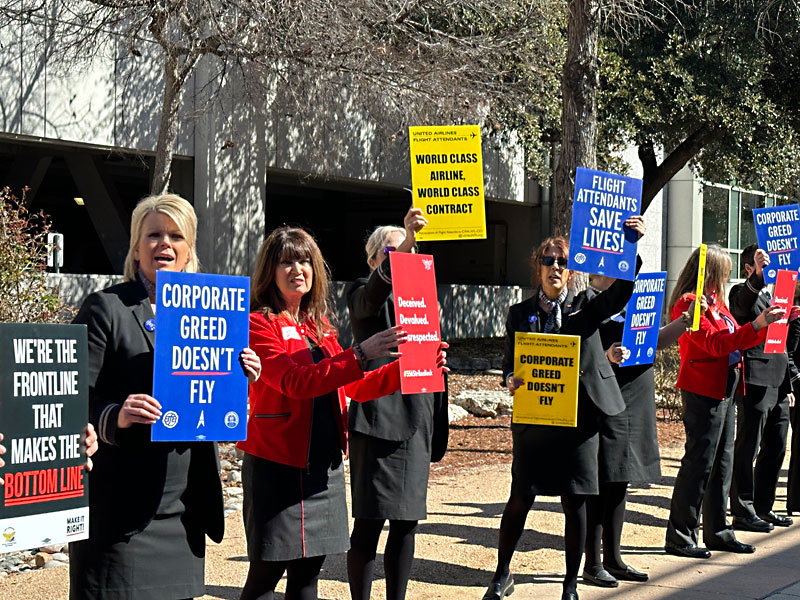Austin Flight Attendants Picket to Be Paid for Work Hours on the Ground
Amid longer delays, they are asking for better conditions as well
By Lina Fisher, Fri., Feb. 16, 2024
Tuesday morning, dozens of unionized flight attendants showed up on their days off to the Austin-Bergstrom International Airport’s pickup area to protest poor working conditions, stagnating wages, and years-long negotiations with their airlines. Thirty airports across the country saw flight attendants from 24 airlines picketing that day for the same reasons, amid a spike in flight traffic since the pandemic, especially in growing markets like Austin.
Three flight attendants for three different airlines gave the Chronicle similar accounts of exhausting working conditions, with one major theme: They’re not paid for any work done on the ground, and that work is increasing. “If that door is not closed, we’re not getting those wages,” said Allison Quiñones, who has been with Southwest Airlines for the five years that they have been locked in contract negotiations without a raise.
With rising inflation and cost of living over that period, Quiñones says even a 25% raise would not make up for how the local economy and job duties have changed. What used to be 30 minutes on the ground in between flights has turned into sometimes more than an hour and a half. “You could be on duty for 11 hours, but you may have spent five hours of that day sitting on the ground, boarding passengers – doing work but not getting paid. What other job can you show up, clock in, and not be paid for full days?”
Kira Silvera with American Airlines, who has 10 years of flying experience – four of which have been spent in negotiations – says in addition to ground pay, the hours create unsafe situations. “You can’t expect flight attendants to work 18-hour days and then safely evacuate an airplane if there’s an emergency,” Silvera said. American Airlines flight attendants don’t get paid overtime for operational issues, and Silvera says in a weather delay situation, “you have flight attendants and crew who are now stuck in a city that they weren’t scheduled to layover at, waiting four to six hours for a hotel. We get lost in the system, they don’t know where we are, so we end up sleeping in the airport. And then you expect us to go to work the next day and be 100 percent.”
These issues are a result of “airlines trying to take advantage of a traveling public,” said Quiñones. “After being shut down for years, people were ready to fly again, and in turn, it caused companies to go out, grab as many takeoff slots that they could, move into new cities, and expand their operations far beyond what they were ready for.” Silvera says AUS in particular “can’t really handle the demand with this infrastructure.” She said some planes land or divert in Austin having no gate, which leaves flight attendants waiting on the runway with passengers for sometimes hours because there is no gate to pull up to.
Pilots at United and Southwest have recently ratified contracts, as airlines are desperate to reduce obstacles to hiring for a position facing a looming shortage. “Our management has the money,” said Silvera. Quiñones points to the Southwest CEO enjoying an almost 100% higher bonus this year than last year, while flight attendants’ wages have stagnated for the last five years.
“We are the reason why profits are high, but they’re not sharing those profits with us,” Quiñones said. “Anytime there’s a delay, anytime there’s any sort of operational issue – anytime passengers are suffering through those things, we’re right there with them.”
Got something to say on the subject? Send a letter to the editor.









